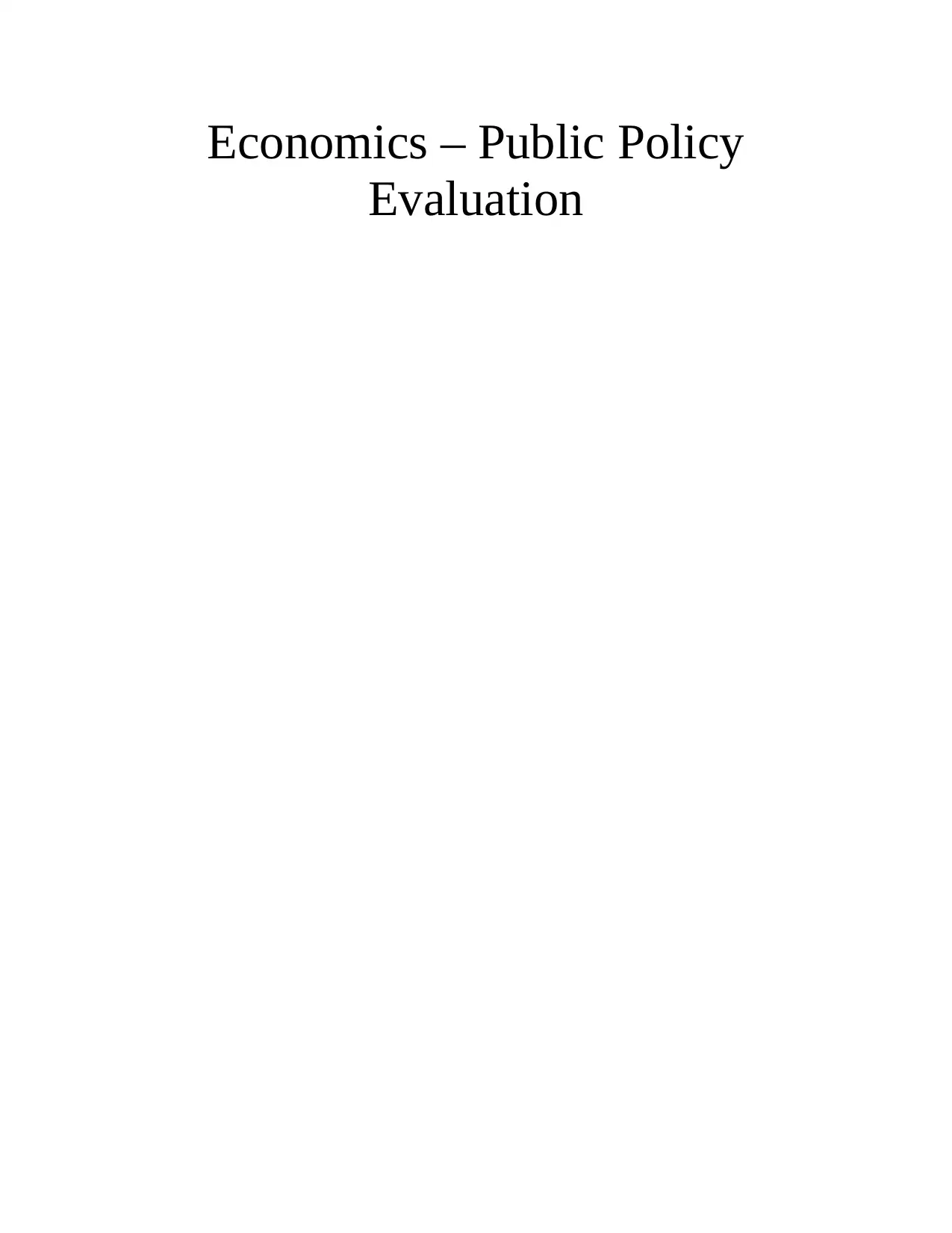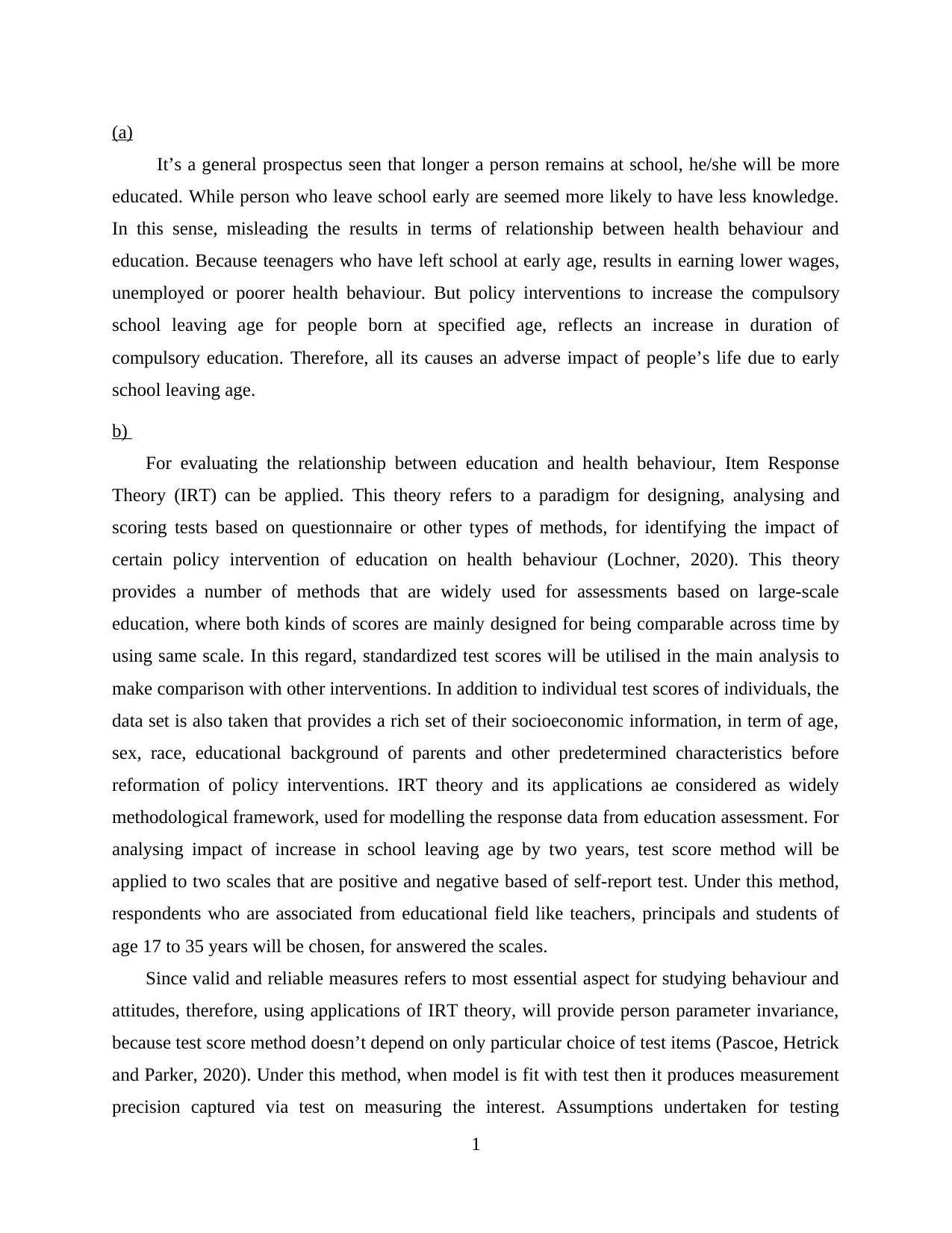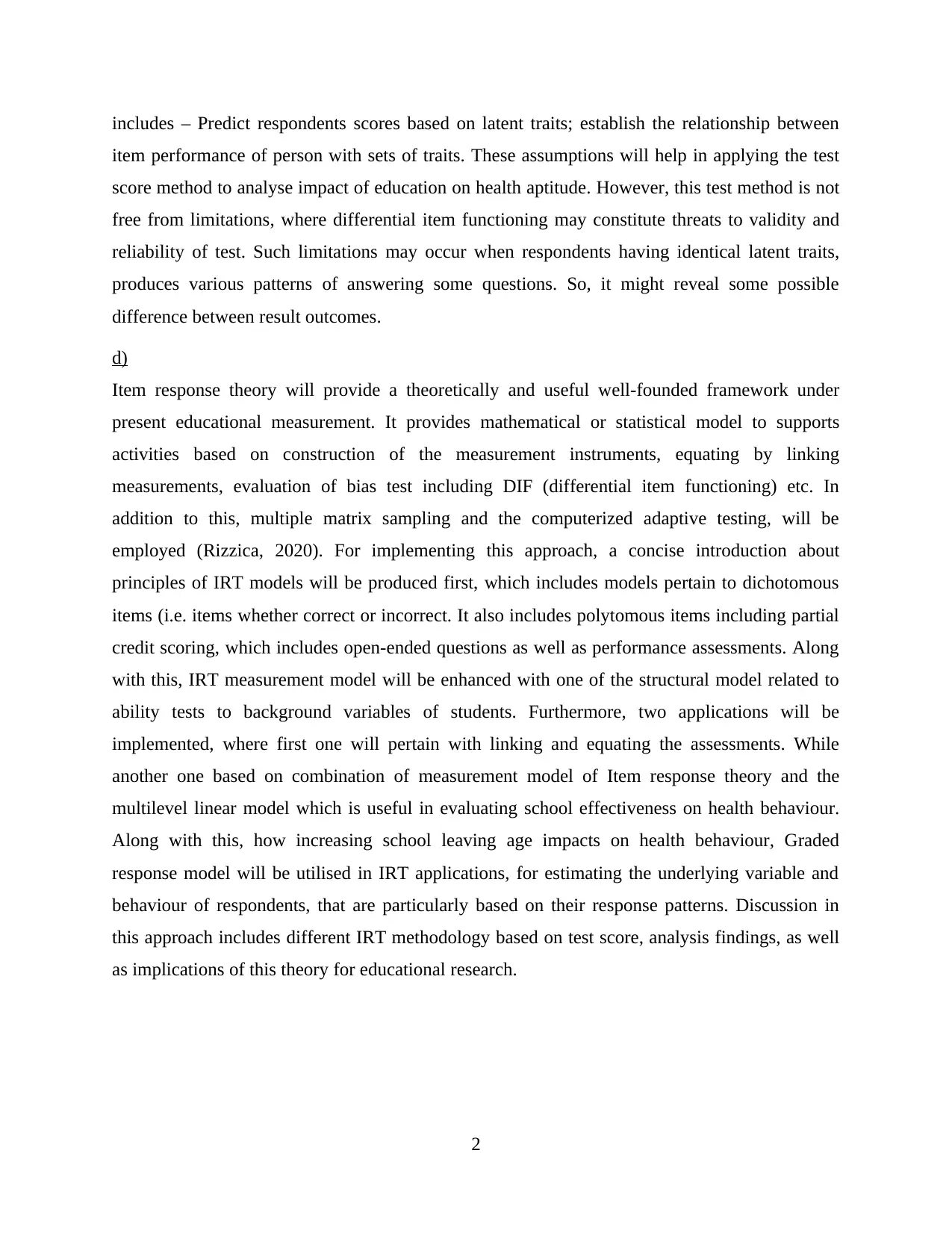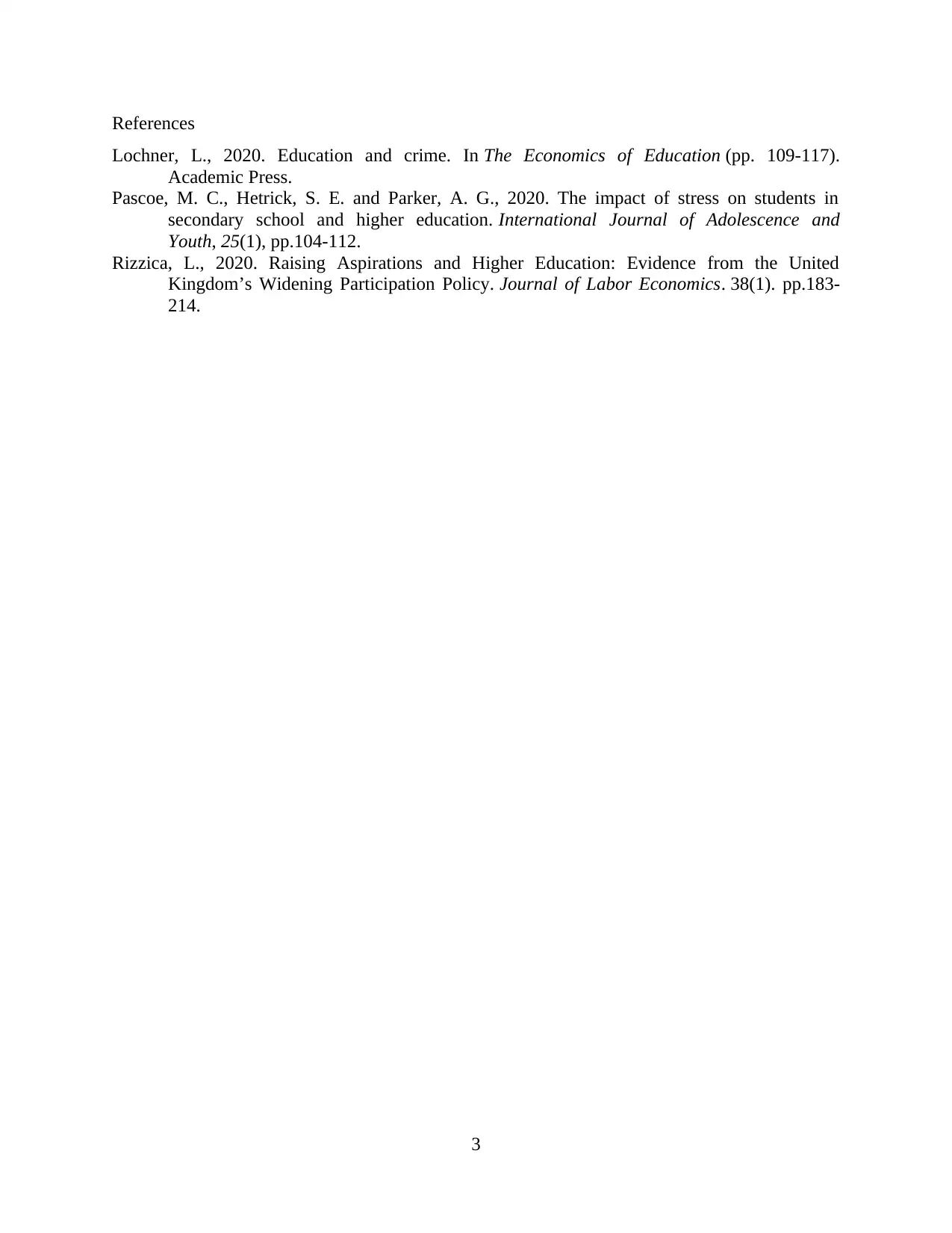University Economics: Public Policy Evaluation and Health Report
VerifiedAdded on 2023/01/10
|5
|945
|78
Report
AI Summary
This report evaluates the effect of education on health behaviors, focusing on a policy intervention that increased the compulsory school leaving age. It explains why simple comparisons between educated and less educated individuals can be misleading and proposes using Item Response Theory (IRT) to analyze the relationship. The report outlines the IRT method, its assumptions, and limitations, including the use of test scores and socioeconomic data to assess policy impacts. It also addresses potential issues arising from within-household variations in exposure to the reform. Furthermore, the report explores the application of IRT, including models for dichotomous and polytomous items, and its use in linking assessments and evaluating school effectiveness. Finally, the report discusses the use of the graded response model to estimate underlying variables and behaviors, providing a comprehensive discussion of IRT methodologies and their implications for educational research.

Economics – Public Policy
Evaluation
Evaluation
Paraphrase This Document
Need a fresh take? Get an instant paraphrase of this document with our AI Paraphraser


(a)
It’s a general prospectus seen that longer a person remains at school, he/she will be more
educated. While person who leave school early are seemed more likely to have less knowledge.
In this sense, misleading the results in terms of relationship between health behaviour and
education. Because teenagers who have left school at early age, results in earning lower wages,
unemployed or poorer health behaviour. But policy interventions to increase the compulsory
school leaving age for people born at specified age, reflects an increase in duration of
compulsory education. Therefore, all its causes an adverse impact of people’s life due to early
school leaving age.
b)
For evaluating the relationship between education and health behaviour, Item Response
Theory (IRT) can be applied. This theory refers to a paradigm for designing, analysing and
scoring tests based on questionnaire or other types of methods, for identifying the impact of
certain policy intervention of education on health behaviour (Lochner, 2020). This theory
provides a number of methods that are widely used for assessments based on large-scale
education, where both kinds of scores are mainly designed for being comparable across time by
using same scale. In this regard, standardized test scores will be utilised in the main analysis to
make comparison with other interventions. In addition to individual test scores of individuals, the
data set is also taken that provides a rich set of their socioeconomic information, in term of age,
sex, race, educational background of parents and other predetermined characteristics before
reformation of policy interventions. IRT theory and its applications ae considered as widely
methodological framework, used for modelling the response data from education assessment. For
analysing impact of increase in school leaving age by two years, test score method will be
applied to two scales that are positive and negative based of self-report test. Under this method,
respondents who are associated from educational field like teachers, principals and students of
age 17 to 35 years will be chosen, for answered the scales.
Since valid and reliable measures refers to most essential aspect for studying behaviour and
attitudes, therefore, using applications of IRT theory, will provide person parameter invariance,
because test score method doesn’t depend on only particular choice of test items (Pascoe, Hetrick
and Parker, 2020). Under this method, when model is fit with test then it produces measurement
precision captured via test on measuring the interest. Assumptions undertaken for testing
1
It’s a general prospectus seen that longer a person remains at school, he/she will be more
educated. While person who leave school early are seemed more likely to have less knowledge.
In this sense, misleading the results in terms of relationship between health behaviour and
education. Because teenagers who have left school at early age, results in earning lower wages,
unemployed or poorer health behaviour. But policy interventions to increase the compulsory
school leaving age for people born at specified age, reflects an increase in duration of
compulsory education. Therefore, all its causes an adverse impact of people’s life due to early
school leaving age.
b)
For evaluating the relationship between education and health behaviour, Item Response
Theory (IRT) can be applied. This theory refers to a paradigm for designing, analysing and
scoring tests based on questionnaire or other types of methods, for identifying the impact of
certain policy intervention of education on health behaviour (Lochner, 2020). This theory
provides a number of methods that are widely used for assessments based on large-scale
education, where both kinds of scores are mainly designed for being comparable across time by
using same scale. In this regard, standardized test scores will be utilised in the main analysis to
make comparison with other interventions. In addition to individual test scores of individuals, the
data set is also taken that provides a rich set of their socioeconomic information, in term of age,
sex, race, educational background of parents and other predetermined characteristics before
reformation of policy interventions. IRT theory and its applications ae considered as widely
methodological framework, used for modelling the response data from education assessment. For
analysing impact of increase in school leaving age by two years, test score method will be
applied to two scales that are positive and negative based of self-report test. Under this method,
respondents who are associated from educational field like teachers, principals and students of
age 17 to 35 years will be chosen, for answered the scales.
Since valid and reliable measures refers to most essential aspect for studying behaviour and
attitudes, therefore, using applications of IRT theory, will provide person parameter invariance,
because test score method doesn’t depend on only particular choice of test items (Pascoe, Hetrick
and Parker, 2020). Under this method, when model is fit with test then it produces measurement
precision captured via test on measuring the interest. Assumptions undertaken for testing
1
⊘ This is a preview!⊘
Do you want full access?
Subscribe today to unlock all pages.

Trusted by 1+ million students worldwide

includes – Predict respondents scores based on latent traits; establish the relationship between
item performance of person with sets of traits. These assumptions will help in applying the test
score method to analyse impact of education on health aptitude. However, this test method is not
free from limitations, where differential item functioning may constitute threats to validity and
reliability of test. Such limitations may occur when respondents having identical latent traits,
produces various patterns of answering some questions. So, it might reveal some possible
difference between result outcomes.
d)
Item response theory will provide a theoretically and useful well-founded framework under
present educational measurement. It provides mathematical or statistical model to supports
activities based on construction of the measurement instruments, equating by linking
measurements, evaluation of bias test including DIF (differential item functioning) etc. In
addition to this, multiple matrix sampling and the computerized adaptive testing, will be
employed (Rizzica, 2020). For implementing this approach, a concise introduction about
principles of IRT models will be produced first, which includes models pertain to dichotomous
items (i.e. items whether correct or incorrect. It also includes polytomous items including partial
credit scoring, which includes open-ended questions as well as performance assessments. Along
with this, IRT measurement model will be enhanced with one of the structural model related to
ability tests to background variables of students. Furthermore, two applications will be
implemented, where first one will pertain with linking and equating the assessments. While
another one based on combination of measurement model of Item response theory and the
multilevel linear model which is useful in evaluating school effectiveness on health behaviour.
Along with this, how increasing school leaving age impacts on health behaviour, Graded
response model will be utilised in IRT applications, for estimating the underlying variable and
behaviour of respondents, that are particularly based on their response patterns. Discussion in
this approach includes different IRT methodology based on test score, analysis findings, as well
as implications of this theory for educational research.
2
item performance of person with sets of traits. These assumptions will help in applying the test
score method to analyse impact of education on health aptitude. However, this test method is not
free from limitations, where differential item functioning may constitute threats to validity and
reliability of test. Such limitations may occur when respondents having identical latent traits,
produces various patterns of answering some questions. So, it might reveal some possible
difference between result outcomes.
d)
Item response theory will provide a theoretically and useful well-founded framework under
present educational measurement. It provides mathematical or statistical model to supports
activities based on construction of the measurement instruments, equating by linking
measurements, evaluation of bias test including DIF (differential item functioning) etc. In
addition to this, multiple matrix sampling and the computerized adaptive testing, will be
employed (Rizzica, 2020). For implementing this approach, a concise introduction about
principles of IRT models will be produced first, which includes models pertain to dichotomous
items (i.e. items whether correct or incorrect. It also includes polytomous items including partial
credit scoring, which includes open-ended questions as well as performance assessments. Along
with this, IRT measurement model will be enhanced with one of the structural model related to
ability tests to background variables of students. Furthermore, two applications will be
implemented, where first one will pertain with linking and equating the assessments. While
another one based on combination of measurement model of Item response theory and the
multilevel linear model which is useful in evaluating school effectiveness on health behaviour.
Along with this, how increasing school leaving age impacts on health behaviour, Graded
response model will be utilised in IRT applications, for estimating the underlying variable and
behaviour of respondents, that are particularly based on their response patterns. Discussion in
this approach includes different IRT methodology based on test score, analysis findings, as well
as implications of this theory for educational research.
2
Paraphrase This Document
Need a fresh take? Get an instant paraphrase of this document with our AI Paraphraser

References
Lochner, L., 2020. Education and crime. In The Economics of Education (pp. 109-117).
Academic Press.
Pascoe, M. C., Hetrick, S. E. and Parker, A. G., 2020. The impact of stress on students in
secondary school and higher education. International Journal of Adolescence and
Youth, 25(1), pp.104-112.
Rizzica, L., 2020. Raising Aspirations and Higher Education: Evidence from the United
Kingdom’s Widening Participation Policy. Journal of Labor Economics. 38(1). pp.183-
214.
3
Lochner, L., 2020. Education and crime. In The Economics of Education (pp. 109-117).
Academic Press.
Pascoe, M. C., Hetrick, S. E. and Parker, A. G., 2020. The impact of stress on students in
secondary school and higher education. International Journal of Adolescence and
Youth, 25(1), pp.104-112.
Rizzica, L., 2020. Raising Aspirations and Higher Education: Evidence from the United
Kingdom’s Widening Participation Policy. Journal of Labor Economics. 38(1). pp.183-
214.
3
1 out of 5
Related Documents
Your All-in-One AI-Powered Toolkit for Academic Success.
+13062052269
info@desklib.com
Available 24*7 on WhatsApp / Email
![[object Object]](/_next/static/media/star-bottom.7253800d.svg)
Unlock your academic potential
Copyright © 2020–2025 A2Z Services. All Rights Reserved. Developed and managed by ZUCOL.





